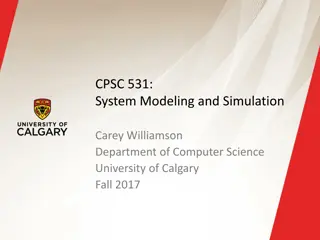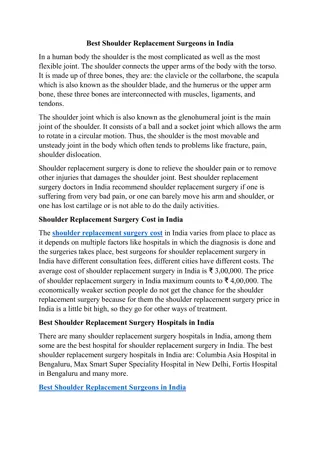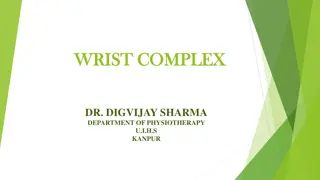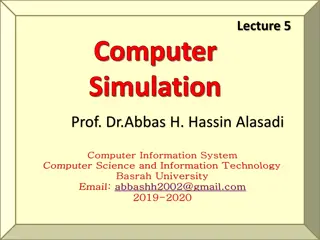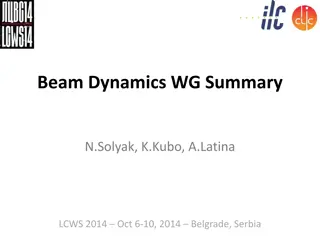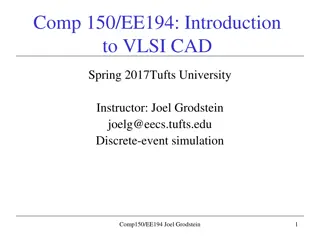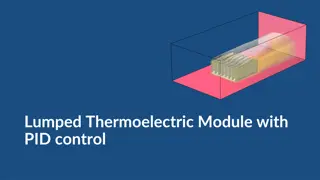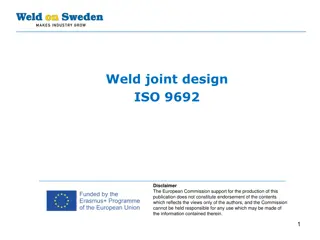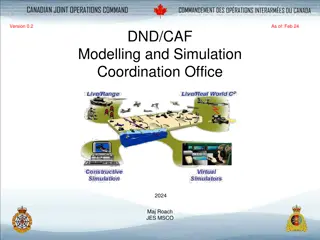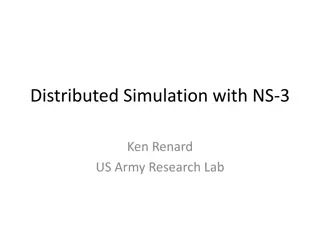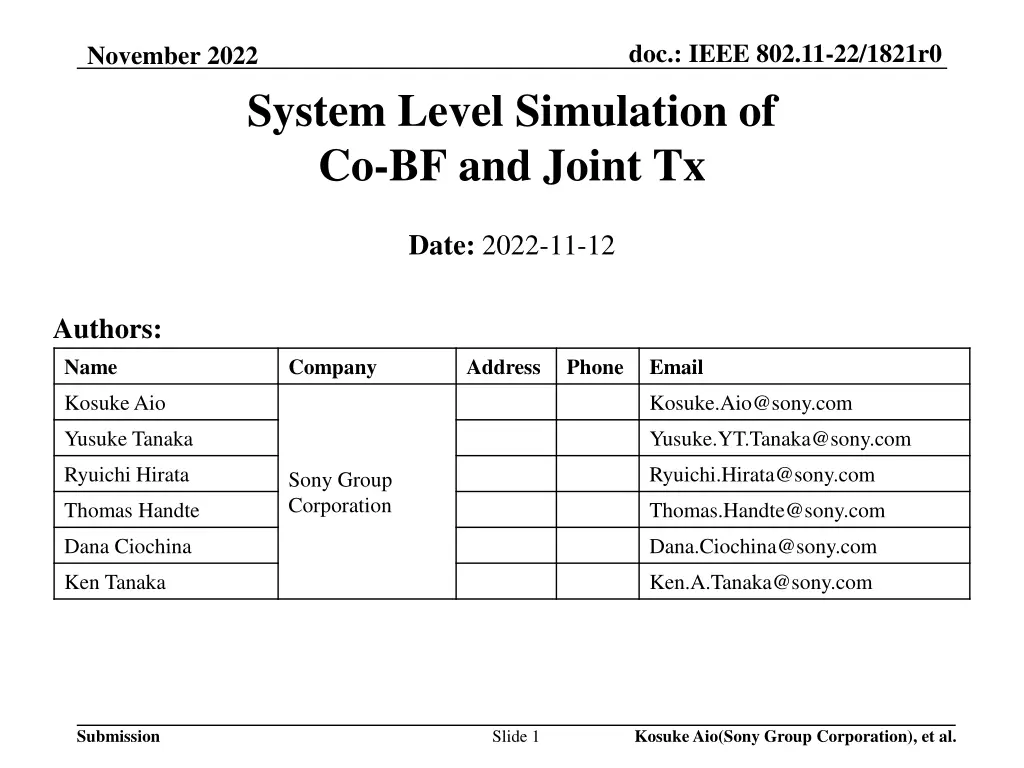
System-Level Simulation of Co-BF and Joint Transmission in IEEE 802.11-22/1821r0
Explore the advanced coordination schemes of Coordinated Beamforming (Co-BF) and Joint Transmission (Joint Tx) in IEEE 802.11-22/1821r0 for Multi-AP coordination. Discover the impact factors and initial performance evaluations of these schemes on system throughput and latency. Dive into the challenges, implementations, and coordination protocols involved in achieving optimal results.
Download Presentation

Please find below an Image/Link to download the presentation.
The content on the website is provided AS IS for your information and personal use only. It may not be sold, licensed, or shared on other websites without obtaining consent from the author. If you encounter any issues during the download, it is possible that the publisher has removed the file from their server.
You are allowed to download the files provided on this website for personal or commercial use, subject to the condition that they are used lawfully. All files are the property of their respective owners.
The content on the website is provided AS IS for your information and personal use only. It may not be sold, licensed, or shared on other websites without obtaining consent from the author.
E N D
Presentation Transcript
doc.: IEEE 802.11-22/1821r0 November 2022 System Level Simulation of Co-BF and Joint Tx Date: 2022-11-12 Authors: Name Company Address Phone Email Kosuke Aio Kosuke.Aio@sony.com Yusuke Tanaka Yusuke.YT.Tanaka@sony.com Ryuichi Hirata Ryuichi.Hirata@sony.com Sony Group Corporation Thomas Handte Thomas.Handte@sony.com Dana Ciochina Dana.Ciochina@sony.com Ken Tanaka Ken.A.Tanaka@sony.com Submission Kosuke Aio(Sony Group Corporation), et al. Slide 1
doc.: IEEE 802.11-22/1821r0 November 2022 Introduction Multi-AP coordination is a candidate feature for next TG as a technology to realize the several objectives and use cases of UHR [1]. Some types of Multi-AP coordination schemes have been discussed in TGbe and approved to be added to the SFD: Joint Transmission (Joint TX) [2] Coordinated Beamforming (Co-BF) [3] Coordinated Spatial Reuse (Co-SR) [4] Coordinated OFDMA (Co-OFDMA) [5] Time/Freq Scheduling [6] This contribution recaps on some of the factors that impact the advanced coordination schemes (Co-BF and Joint Tx) and show an initial evaluation of their effects on the performance. Submission Kosuke Aio(Sony Corporation), et al. Slide 2
doc.: IEEE 802.11-22/1821r0 November 2022 Advanced Coordination Types Coordinated Beamforming (Co-BF) Each AP independently performs beamforming to reduce interference to other devices. Less difficult to realize than Joint Tx (no need of tight synchronization and data sharing) Joint Transmission (Joint Tx) Multiple APs perform beamforming with sharing Tx antennas to reduce interference to other devices. Theoretically expect the highest throughput gain by using more spatial streams than Co-BF, but there are several issues to be addressed (HW impairment, Data sharing overhead, etc.) x2 Coordinated BF Joint Transmission Submission Kosuke Aio(Sony Corporation), et al. Slide 3
doc.: IEEE 802.11-22/1821r0 November 2022 Current Status about Joint Tx issues HW impairments Joint Tx requires tight time/frequency synchronization between multiple APs. This issue had been discussed/considered in TGbe. The use of like sync trigger before Joint Tx can synchronize transmission time [7]. CFO of around 20 Hz between APs is feasible to implement [8] The use of mid-amble in addition to 20 Hz CFO between APs allows the phase drift during Joint Tx to be properly compensated and keep its characteristics. [9] Data Sharing Overhead Joint Tx sends the same data between APs, so the time required for pre-sharing can be a system overhead. TGbe has discussed at least 10Gbps backhaul speed will be required to achieve high performance [10] To see how much Data Sharing Overhead is affected, we conducted simulation evaluation of system performance of Co-BF and Joint Tx. Submission Kosuke Aio(Sony Corporation), et al. Slide 4
doc.: IEEE 802.11-22/1821r0 November 2022 Simulation Assumption Two Criteria: System Throughput & Latency (Queuing Delay) Wired Backhaul Case Lan cable speed is 10Gbps. No jitter/No error. AP1 makes decision of the coordination availability, Shared AP from candidates APs(AP2), and sends weight for Joint TX. Coordination Protocol Policy AP1/AP2 exchange coordination request/response frames to setup coordination. Only when Joint Tx, AP1/AP2 share data via backhaul. When Candidate AP has no traffic, only Sharing AP transmits data (after coordination req./resp. exchange). An example sequence is shown on the next page (Other sequences are in Appendix) Submission Kosuke Aio(Sony Corporation), et al. Slide 5
doc.: IEEE 802.11-22/1821r0 November 2022 Example of Coordination Protocol Sequence Skip in Co-BF Coord. Set Coord. Trigger Coord. Req Data AP1 Data Sharing (Sharing AP) Data AP2 (Shared AP) Coord. Resp STAs Block Ack 1. 2. AP1 becomes Sharing AP. AP1 and AP2 exchange Coordination Req./Resp to decide if coordination should be started or not, who is Shared AP, and which packets will be sent based on information obtained. AP1 sends Coordination Set to AP2 to start Data Sharing between them via backhaul. During Data Sharing, AP1 and AP2 wait transmission for a certain period. For Co-BF, this phase is skipped. AP1 sends Coordination Trigger to AP2 to start Coordination transmission. AP1 and AP2 receives Block Ack from each intra-BSS STA. Block Ack is sent by UL OFDMA in 20MHz units. Trigger frames is included in Data frame 3. 4. 5. Submission Kosuke Aio(Sony Corporation), et al. Slide 6
doc.: IEEE 802.11-22/1821r0 November 2022 Simulation Scenario Parameters Scenario Freq, BW Packet Size Max Aggregation Size PPDU MCS Num. of Ant Tx Power Tx Spatial Stream per STA, Coding Fading Model Pathloss Model Shadowing RTS/CTS BF Matrix Parameters Doppler Frequency Sounding Interval 5180MHz, 80MHz 1500 byte 64 or 256 HE, short Guard Interval Data: MCS0 11, Control : Fixed MCS0 (Tx, Rx) = (4,2) AP: 21dBm, STA:15dBm 1 or 2, SVD-MMSE TGac_D NLOS for all the links Eq.(1) 5dB log-normal for all link Enable ( , ) = (9, 7), Grouping = 4 0Hz 100ms 1 STA per room is dropped randomly to be associated with an AP in the same room. Evaluate 100 drops. Simulation time of each drop is 20s. Eq.(1) : PL(d) = 40.05 + 20*log10(freq/2.4)+ 20*log10(min(Dis, bp)) + (Dis > bp) .* (35*log10(Dis/bp)) + Wn * 10dB ( freq = 5.18GHz, Dis = Tx/Rx distance, bp = 5m) Assumption Compared only non-coordination (TDMA), Coordinated BF, and Joint Tx. All new control frames for coordination are set to 40byte. No HW impairments are considered at this stage. Submission Kosuke Aio(Sony Corporation), et al. Slide 7
doc.: IEEE 802.11-22/1821r0 November 2022 Simulation Setup We prepare two setups for system throughput evaluation and low latency (queuing delay) evaluation each. Setup(A) Setup(B) System Thruput Evaluation Latency Evaluation AP1: DL-only, CBR, 1600Mbps AP2: DL-only, CBR, 1600Mbps (Both Full Traffic) AP1: DL-only, CBR, 100Mbps AP2: DL-only, FTP, File size = 30kByte, arrival rate = 10/1s Traffic Model Max Aggregation Number TxSS per STA MCS 256 64 1 or 2 1 Optimization by SINR*1 (max MCS11) Fixed. AP1 = MCS7, AP2=MCS4 Queuing delay of AP2 (from queuing to transmission start) Metric Throughput of total AP1 and AP2 *1 : Maximum MCS that satisfies PER=5% or less for given SINR Submission Kosuke Aio(Sony Corporation), et al. Slide 8
doc.: IEEE 802.11-22/1821r0 November 2022 Simulation Result (1/4) TxSS=2: plot min SINR between 1st and 2nd stream No Coordination: plot SINR when AP1/AP2 sends at the same time SINR at STA SINR at STA1 SINR at STA2 SINR Gain From No Coord. at cdf=0.5 - Co-BF (TXSS=1) : 16.6dB - Co-BF (TXSS=2) : 11.9dB - Joint Tx (TXSS=1) : 32.1dB - Joint Tx (TXSS=2) : 28.9dB SINR Gain From No Coord. at cdf=0.5 - Co-BF (TXSS=1) : 15.2dB - Co-BF (TXSS=2) : 6.5dB - Joint Tx (TXSS=1) : 23.8dB - Joint Tx (TXSS=2) : 21.9dB CDF CDF Joint Tx can achieve stable and high SINR (>30dB, TxSS irrelevant) Co-BF is likely to have unstable SINR and low MCS as the number of TxSS increases (especially STA2) Submission Kosuke Aio(Sony Corporation), et al. Slide 9
doc.: IEEE 802.11-22/1821r0 November 2022 Simulation Result (2/4) System Throughput Evaluation Result TxSS per STA = 1 TxSS per STA = 2 Throughput Gain From No Coord. at cdf=0.5 - Co-BF : x0.99 - Joint Tx :x1.45 CDF Throughput Gain From No Coord. at cdf=0.5 - Co-BF : x1.73 - Joint Tx :x1.77 CDF When TxSS=1, Joint TX and Co-BF performance do not change significantly, but when TxSS=2, Co-BF deteriorates in some cases compared to non-coordination. TDMA at high MCS is better than simultaneous transmission at low MCS in many cases. Submission Kosuke Aio(Sony Corporation), et al. Slide 10
doc.: IEEE 802.11-22/1821r0 November 2022 Simulation Result (3/4) Latency Evaluation Result (CDF in on example drop) Delay Prob <5ms Avg Worst No Coord. 56.65% 5.28ms 35.76ms CDF Co-BF 83.90% 2.64ms 8.41ms Joint Tx 82.38% 2.86ms 8.63ms Both types can decrease the queuing delay much. Co-BF achieves slightly lower queuing delay than Joint Tx due to data sharing overhead. Submission Kosuke Aio(Sony Corporation), et al. Slide 11
doc.: IEEE 802.11-22/1821r0 November 2022 Simulation Result (4/4) Latency Evaluation Result (Histogram in All Drops) Average Worst Mean Value - No Coord.: 29.25ms - Co-BF : 8.05ms - Joint Tx :8.27ms Mean Value - No Coord.: 5.30ms - Co-BF : 2.63ms - Joint Tx :2.85ms Both types can decrease the queuing delay significantly, especially worst-case delay. Submission Kosuke Aio(Sony Corporation), et al. Slide 12
doc.: IEEE 802.11-22/1821r0 November 2022 Observation Even if considering data sharing overhead, Joint Tx has the potential to simultaneously satisfy high throughput and low latency. When TxSS = 2, only Joint Tx can achieve high system throughput gain. Queuing delay is slightly higher than Co-BF, but still lower than when uncoordinated. If 10Gbps Ethernet cables become the mainstream in the future, we can expect this level of performance from Joint Tx, even if including data sharing overhead. Also, Co-BF can achieve good performance in situations where high throughput is not required and there is room for antenna freedom. When TxSS = 1, system throughput gain is much high and almost same as Joint Tx. Co-BF can achieve lower queuing delay than Joint Tx due to data sharing overhead. If we include not only queuing delay but also other delays (e.g. retransmission delay), the difference with Joint Tx may be even larger We prefer to use these two methods of coordination, depending on the environment and requirements. Submission Kosuke Aio(Sony Corporation), et al. Slide 13
doc.: IEEE 802.11-22/1821r0 November 2022 Further Discussion In order to increase the number of situations where Joint Tx can be deployed, several remaining factors regarding data sharing must be considered in the future. Low Backhaul Speed (Old Ether cable, Wireless backhaul, and so on) Internal Delay via Upper layer of AP (such as Linux) Solution to reduce data sharing can be further discussed in the next TG. For example: Complete data sharing in advance, not just before Joint Tx. For Mesh environment, data sharing will become overhead-less. Increasing complexity of packet management will be a big concern. During data sharing, packet transmission to other STAs to improve efficiency. It would be a good way to start Joint Tx discussion with a simple scenario first, and then discuss possible extensions in the future. Submission Kosuke Aio(Sony Corporation), et al. Slide 14
doc.: IEEE 802.11-22/1821r0 November 2022 Summary We discussed issues of advanced coordination types (Joint Tx and Co-BF) We provided simulation results to show the potential performance of Joint Tx and Co-BF. Joint Tx in 10Gbps LAN scenario has the potential to simultaneously satisfy high throughput and low latency, even if data sharing overhead. Co-BF can achieve very high performance in situations where high throughput is not required and there is room for antenna freedom. It seems that standardization of both coordination methods makes sense such that the implementation can choose the appropriate coordination type depending on the environment and requirements. Submission Kosuke Aio(Sony Corporation), et al. Slide 15
doc.: IEEE 802.11-22/1821r0 November 2022 Reference [1] Yusuke Tanaka (Sony Group Corporation), Considerations on Multi-AP Coordination, 22/1516r0, September 2022. [2] Ron Porat (Broadcom), Joint transmission for 11be, 20/0071r1, April 2020. [3] Roya Doostnejad (Intel), Coordinated beamforming for 802.11be, 20/0099r1, April 2020. [4] Jason Yuchen Guo (Huawei), Coordinated spatial reuse operation, 20/0033r1, February 2020. [5] Liwen Chu (NXP), Coordinated OFDMA, 19/1919r3, January 2020. [6] Lochan Verma (Qualcomm), Coordinated AP time/frequency sharing in a transmit opportunity in 11be, 19/1582r2, January 2020. [7] Ron Porat (Broadcom), Distributed MU MIMO Simulations, 18/1962r0, November 2018. [8] Ron Porat (Broadcom), Joint Processing MU-MIMO Update, 19/0800r0,May 2019. [9] Sudhir Srinivasa (Marvell), Joint BF Simulations, 19/1094r0, July 2020. [10] Sigurd Schelstraete (Quantenna Communications), Multi-AP backhaul analysis, 19/1588r0, September 2019 Submission Kosuke Aio(Sony Corporation), et al. Slide 16

